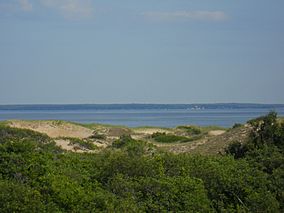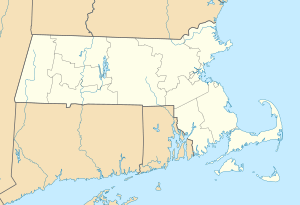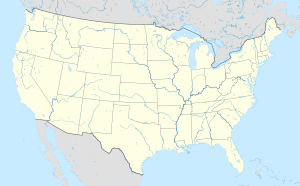Parker River National Wildlife Refuge facts for kids
Quick facts for kids Parker River National Wildlife Refuge |
|
|---|---|
|
IUCN Category IV (Habitat/Species Management Area)
|
|

View from the top of the dunes trail, center of refuge
|
|
| Location | Plum Island (Massachusetts), United States |
| Nearest city | Newburyport, Massachusetts |
| Area | 4,662 acres (18.87 km2) |
| Established | 1942 |
| Governing body | U.S. Fish and Wildlife Service |
| Website | Parker River National Wildlife Refuge |
The Parker River National Wildlife Refuge is a special place for wildlife. It's a huge wildlife sanctuary on Plum Island in Massachusetts, USA. This refuge was created in 1942 to give migratory birds a safe place to eat, rest, and build nests.
It's located along the Atlantic Flyway, which is like a superhighway for birds. Millions of birds use this route to travel between their breeding and wintering grounds. The refuge is a very important stop for waterfowl (like ducks and geese), shorebirds, and songbirds during their long journeys.
In 1985, a group called The Trust for Public Land helped add more land to the refuge. Besides being a home for birds and other animals, the refuge is also a beautiful place for people. Visitors can swim, hike, surf, fish, and watch birds in this amazing coastal area.
Contents
What Makes the Refuge Special?
The Parker River National Wildlife Refuge covers a large part of Plum Island. This island is about 8 miles (13 km) long and sits off the coast of Massachusetts. The refuge also includes the mouth of the Parker River and all the smaller islands within Plum Island Sound.
The area is famous for its huge marsh, known as the Great Marsh. This marsh has winding rivers and channels. The refuge protects about 4,662 acres (18.87 km²) of different natural areas.
These areas include:
- Sandy beaches and dunes
- Shrubby areas and thickets
- Bogs and swamps
- Freshwater marshes
- Saltwater marshes with creeks and mudflats
- New salt pannes (shallow pools)
These different habitats are home to many kinds of wildlife. More than 300 species of birds live here or visit. You can also find many types of mammals, reptiles, amphibians, insects, and plants.
Things to Do and See
The refuge offers many ways for visitors to enjoy nature. You can hike, jog, or cycle along Plum Island Drive when the refuge is open. Taking photos is allowed in all public areas.
If you love the beach, you can visit it using boardwalks. But remember, this is only allowed outside of bird nesting season. In the autumn, you can even drive on parts of the beach for licensed fishing. You access these areas through roads that go over the dunes.
The refuge also manages its wildlife. For example, controlled deer hunting is allowed on one day each year to keep the deer population healthy. This is carefully managed by park staff and volunteers. Shellfishing is also allowed in one specific area during certain seasons.
If you enjoy birdwatching, there's a special area for licensed wildfowl hunting on the Parker River. You need to get to this area from the mainland side. There are also new visitor facilities with exhibits and programs near Plum Island Airport. These are great places to learn more about the refuge.
How the Refuge Has Changed
The island's environment has changed over time. In the past, people drained parts of the Great Marsh to create parallel channels. They also used the dunes too much, which made them unstable. Farmers used to clear land for crops and cut marsh grass for hay.
Pollution from the Merrimack River and dams on its streams also affected the fish and the birds that ate them. Even today, currents from the Merrimack River can bring trash to the beach. Volunteers often help clean up the beach.
When the refuge was created, the farmland was bought and cleared. To help stabilize the dunes, people planted Black Pine trees. These trees are not native to the area. The refuge also created artificial freshwater pools to help bring back different types of plants and animals.
More recently, heavy equipment has been used to restore the marsh. They replaced the old parallel channels with unconnected pools, making the marsh more like it was originally. Because the public is not allowed on the beach during summer, seals from the Atlantic Ocean now often come to rest there.
Images for kids





